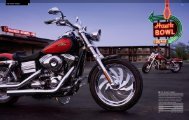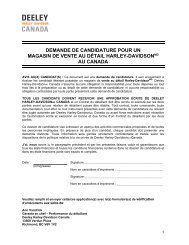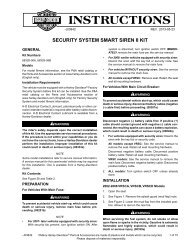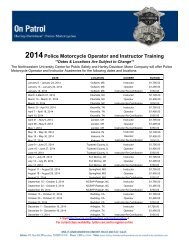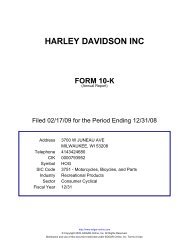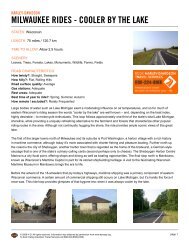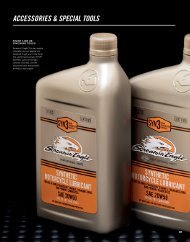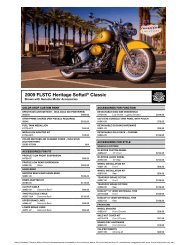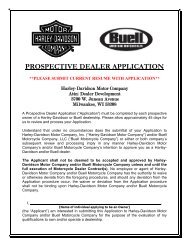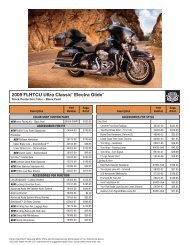EXPERIENCEBUSINESS - Harley-Davidson
EXPERIENCEBUSINESS - Harley-Davidson
EXPERIENCEBUSINESS - Harley-Davidson
Create successful ePaper yourself
Turn your PDF publications into a flip-book with our unique Google optimized e-Paper software.
MANAGEMENT’ S DISCUSSION AND ANALYSIS OF FINANCIAL<br />
CONDITION AND RESULTS OF OPERATIONS<br />
OPERATING INCOME FROM FINANCIAL SERVICES The<br />
Financial Services segment reported operating income of<br />
$27.7 million for 1999, an increase of $7.5 million, or 37%<br />
over 1998 levels. This increase was due to growth in all business<br />
lines during 1999. The growth was particularly strong in<br />
retail installment lending where HDFS experienced increases<br />
in both market share and profitability. During 1999, HDFS<br />
financed 22% of new <strong>Harley</strong>-<strong>Davidson</strong> ® motorcycles retailed<br />
in the U.S., up from 21% in 1998. Additionally, increased<br />
volumes and outstandings in the wholesale lending business<br />
and commission revenue growth from the insurance agency<br />
business contributed to increased operating income in 1999.<br />
OTHER Other expense for 1999 was $1.9 million higher than<br />
in 1998. Included in 1998 other expense is a $1.8 million onetime<br />
benefit related to a rebate of harbor maintenance fees.<br />
The levy of these fees was found unconstitutional by the U.S.<br />
Supreme Court and related to fees collected over the previous<br />
five years. Other non-operating expense items, including<br />
foreign currency exchange losses, remained consistent from<br />
1998 to 1999.<br />
INTEREST INCOME 1999 interest income was higher than in<br />
the prior year primarily due to higher levels of cash available<br />
for short-term investing when compared to 1998.<br />
CONSOLIDATED INCOME TAXES The Company’s effective<br />
tax rate was 36.5% in 1999 and 1998.<br />
OTHER MATTERS<br />
ACCOUNTING CHANGES In June 1998, the Financial<br />
Accounting Standards Board issued Statement of Financial<br />
Accounting Standards (SFAS) 133, “Accounting for Derivative<br />
Instruments and for Hedging Activities,” which in its amended<br />
form is effective for fiscal years beginning after June 15, 2000.<br />
The statement requires the Company to recognize all derivatives<br />
on the balance sheet at fair value. Derivatives that are not<br />
hedges must be adjusted to fair value through income. If the<br />
derivative is a hedge, depending on the nature of the hedge,<br />
changes in the fair value will either be offset against the change<br />
in fair value of hedged assets, liabilities or firm commitments<br />
through earnings or recognized in other comprehensive income<br />
until the hedged item is recognized in earnings. The ineffective<br />
portion of a hedge’s change in fair value will be immediately<br />
recognized in earnings. The Company anticipates it will continue<br />
to use derivatives to reduce the impact of fluctuations in<br />
exchange rates and interest rates. The Company intends for the<br />
derivatives to qualify as cash flow hedges in accordance with<br />
SFAS 133. The Company also intends that the net gain or loss<br />
on the derivative instruments designated and qualifying as cash<br />
flow hedges will be reported in comprehensive income. The<br />
adoption of SFAS 133 will not have a material impact on the<br />
Company’s statement of income.<br />
ENVIRONMENTAL MATTERS The Company’s policy is to<br />
comply with all applicable environmental laws and regulations,<br />
and the Company has a compliance program in place<br />
to monitor and report on environmental issues. The<br />
Company has reached a settlement agreement with the U.S.<br />
Navy regarding groundwater remediation at the Company’s<br />
manufacturing facility in York, Pennsylvania and currently<br />
estimates that it will incur approximately $5.4 million of net<br />
additional costs related to the remediation effort. (1) The<br />
Company has established reserves for this amount. The<br />
Company’s estimate of additional response costs is based on<br />
35



